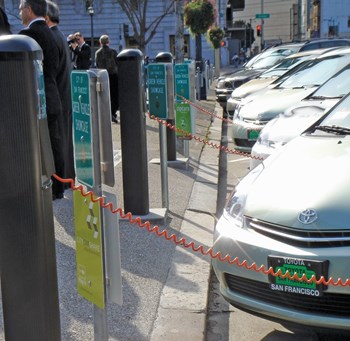
When it comes to being green, New England’s condos have gone far beyond recycling bins. They’re doing everything from recycling water and switching to cleaner propane-powered gasoline lawnmowers to installing bike racks and walking trails.
But some of the biggest changes that will help wean condominium dwellers off gasoline may soon be coming from the parking lot.
Many condominiums in and around Boston now host the car-sharing firm Zipcar, while others encourage unit owners to commute by bike or use mass transit. The car-sharing industry in North America as a whole is rapidly expanding, with a membership of morethan 4.4 million people estimated by 2016, according to the consulting firm Frost & Sullivan.
Sharing Resources “OK”
“We’ve had lots of great opportunity and success stories at condominium associations in the Boston area,” says Dan Curtin, general manager of Zipcar. “It’s an audience who is used to the idea that shared resources are OK.”
Curtin says that every Zipcar represents 15 to 20 individually-owned cars taken off the road, and that up to 40 percent of its members say they have either sold their car or elected not to purchase a new one. The decrease can help with parking issues at condos, sometimes dramatically, and Curtin says condo developers are increasingly interested in the potential savings. (It takes 50 members for Zipcar to install one car, so densely populated areas are key.) Car-sharing members also saythe financial savings can be considerable, saving them $650 or more a month, Curtin notes, including car loan payment, insurance, fuel, repairs and parking.
Car-sharing is a “great solution” for people who want to get away from gas, says Mollie Silver of the Green Round-tablein Boston. She also encourages condominiums to consider offering incentives to residents who use alternate forms of transportation, such as biking.
“You just want to make sure that theoptions you provide will look more appealing than using a car,” Silver says. “Convenience is the number one issue.” Bike racks, walking trails, and shelters that are used while waiting for public transportation are among options that some condos have installed to make not using a car more attractive.
Typically, Curtin says, Zipcar pays to rent a parking space or two at a condo, although sometimes the association letsthem have the space for free. Zipcar also will meet specific requests, such as one upscale condo in Boston’s Back Bay that now hosts a BMW and a hybrid for car-sharing.
While all it takes is a parking space and enough resident interest to get involved in car sharing, another alternative form of transportation – the electric car –is going to take more advanced planning.
General Motors’ announcement that its electric car – the Chevy Volt, listing at $41,000 before a $7,500 federal tax credit –would be rolling out in showrooms in Connecticut, New York, and New Jersey before the end of the year has early adopters eager to take a test drive.
The electric Nissan Leaf, listed at $32,780 and available through an online reservation system, will go on sale in December. A 2008 Morgan Stanley report estimated there could beas many as 100,000 electric vehicles on America's roads by 2012, but at least one energy expert interviewed called that “a little optimistic.”
Electric Cars Pose Challenges for Condos
While environmental activists may cheer their imminent arrival, new electric cars pose special challenges for multi-family homes.
For single-family homes, charging an electric car will be as simple as pulling into the garage. But for condominiums and cooperatives, the question of who pays for installing the charging equipment and wiring – not to mention the electricity – is a more complicated issue.
Experts agree that community associations should start considering whether they plan to accommodate the new electric vehicles –preferably before owners start trying to dangle an extension cord out of their fourth-floor unit.
If no plan is in place, “what you mayend up with is somebody putting an extension cord out the back window,” says Rob Peterson, manager for Volt communications. “It’ll work, but ...”
Most of New England still has months to prepare, since only Connecticut will have Volts rolling along its streets by 2011.
“We have the luxury of seeing what New York, Connecticut and New Jerseydo and see what issues arise,” says attorney Stephen Marcus, a principal of Marcus, Errico, Emmer & Brooks, P.C., in Braintree, Massachusetts. “It’s better to be ready proactively than to wait for the person to buy the vehicle. I would hope the answer wouldn’t be as simple as a ‘No.’ ”
But the bottom line? “It’s coming,” says Marcus. “Associations are going to have to adjust.”
New York Preparing for Electric Cars
In New York, those adjustments are beginning to take place –although most of the management firms contacted for this article said that no one had yet inquired about accommodations for electric cars and that they had yet to weigh their options.
“I see it more as an outer borough issue, where you have 50 parking spacesto assign with a long waiting list,” says Mary Ann Rothman, executive director of the Council of New York Cooperatives & Condominiums (CNYC). In Manhattan, where individuals typically pay to rent a parking space in a garage, she believes it will be less of an issue.
Rothman wonders if the law of supply and demand might kick in, at least in the short term. “Are spaces so in demand that boards will make the somewhat easy answer that if you buy an electric car, you're on your own?” she asks.
But at least one management company is trying to find a way to say yes.
“We have one high-rise condo wrestling with the issue. We have an underground and an above-ground garage. We can easily wire the underground garage to bring the electric to the parking spaces, but at whose cost? The current thought is to make it a pay-for-play kind of thing: If you want it, the building will provide it, but youmust pay for the installation, and the outlet will be separately metered and re-billed directly to the owner,” says a community association manager, who asked that his name not be used.
“The above-ground garage is really just open space with a sun shield erected. No one who parks in this areahas requested that electricity be made available, but we’re fairly certain it’s coming,” he adds. “As yet we do not have an equitable solution.”
In an effort to help encourage electric vehicles, Mayor Michael R. Bloomberg opened New York’s first electric charger in a commercial parking garage on July 14. The manufacturer, Coloumb Technologies, a California-based firm, reportedly hopes to have 5,000 of the chargers installed around the U.S. by 2011. Other cities in line for the chargers include San Francisco, Detroitand Austin, Texas.
Wiring for Charging Raises Difficulties
Townhouse-style condominiums with individual garages shouldn’t be too difficult to wire, energy experts say, especially if the homes have individual meters. (Although in [New York City’s] outer boroughs, many individual garages are not wired for electricity, points out James Goldstick, vice president of Mark Greenberg RealEstate Co. LLC.)
But “if it’s open parking or a carport, quite often these don’t have electricity,” says Hawk Asgeirsson, manager of power systems technology for DTE Energy in Detroit. “What do you do? How do you get electricity to the cars, and who's going to pay for it?”
Asgeirsson explains that, while manufacturers have yet to release final pricing, indoor, garage-mounted charging units likely will run between $500 and $1,000. Outdoor units will cost between $1,000 and $5,000. Each charger could handle two cars. Wiring and installation would run between $2,000 and $10,000, he says, depending on how far the wires neededto be run and whether asphalt needed to be ripped up.
As for the question of who foots the bill?
“The association could collectively decide it’s for the greater good,” says Asgeirsson, and attach charging stations to a central meter. “Everybody pays for it that way. They’d pay to wire the carports and install the charging stationsand split the bill up.”
But in a tough economy, many folksmay not be willing or able to donate extra greenbacks to pay for another person’s green wheels.
At that point, Asgeirsson says, “If a person is assigned a parking spot close to the building, they could get a charging station put in for their residence. It doesn’t have to be indoors; it can be an outdoor unit. They could get it tied to their electric service.”
If the parking lot were all wired at once, it would reduce the per-unit cost. “It would be easier for everybody,” he says.
Could a condominium association or building owner decide that they want to get into the refueling business, and have electric car owners drive up, plugin and pay a fee?
“There are some regulatory issues with that,” says Asgeirsson, calling that notion impractical under today’s laws. “If you start reselling electricity, you become regulated by the public services in each state.”
Instead, he says that the model that parking structures are considering wouldsimply have them charge customers more to park in a spot that has a plug-in.
Those who rely on on-street parking are probably not going to have an easyanswer, should they wish to purchase a plug-in vehicle.
“My brother lives in a co-op with an extremely limited number of parking spaces,” Rothman says with a laugh. “I can see him trying to run an extensioncord down from the seventh floor.”
“When I look at New York, it’s a mega-city. This is going to be a challenge,” says Peterson. “Other manufacturers are coming right behind us. Those people are going to have vehicles out on the road as well. [As electric cars enter the mainstream], we’re going to see more and more apartment dwellers and condominium owners with electric vehicles looking for placesto plug in.”
A look at Los Angeles offers a clue as to how the charging question could play out. Los Angeles has more recent experience with electric vehicles, since General Motors sold its EV-1 there from 1997 to 2002.
A Los Angeles property manager, who requested his name not be used, believes that, based on dealing with other green issues, most area associations will at least listen to electric vehicle owners and allow them to submit proposals for an on-site charging station. They might stipulate that the car owner use an association-approved electrician and cover the costs themselves, or, in the case of larger developments with significant parking, perhaps the association will decide to absorb the costs of installing a charging station or sharethem among electric-vehicle owners living on-site,
“Bottom line, given a level-headed board of directors and a good managementfirm, I don't see any issues with owners being able to have an electric vehicle parked on common grounds with a charging station attached to it, as long as the owner is willing to pay for the costs to do so.”
Propane-powered Lawnmowers
Another way that some condo-miniums are getting away from gas involves switching to propane-powered lawnmowers, typically when their legacygas models are worn out. Switching from a gas-powered mower to a propane lawnmower offers several benefits. According to the Environ-mental Protection Agency, a typical 4-hp gasoline lawn mower engine generates nearly six times as many volatile organic compounds per hour than a car.
A propane version burns cleaner, reducing emissions of ozone precursorsby one-third. Propane mowers also boast 14 percent better fuel economy. Conversion kits are available, but since 2006, it’s possible to purchase a propane mower right off the assembly line, minimizing complications.
For communities where smog alerts are common, making the switch makeseven more sense: Mowers running on propane can be operated even during bans affecting gas lawn mowers.
Just one more reason for condos to move away from gasoline.
Yvonne Zipp is a freelance writer and a frequent contributor to New England Condominium magazine.






Leave a Comment